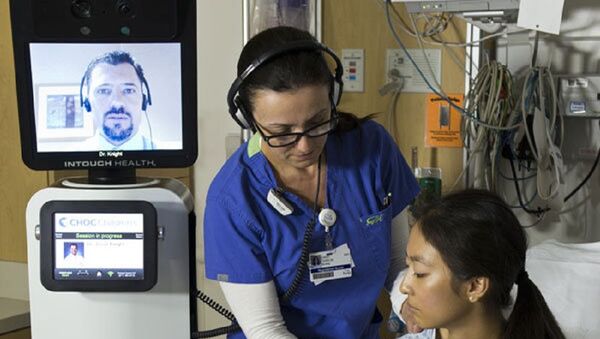WASHINGTON, May 7 (RIA Novosti) – A new kind of doctor has begun making the rounds at seven North American hospitals , where a robot glides from bedside to bedside, taking physicians to their patients for remote consultations.
Called the Remote Presence Virtual + Independent Telemedicine Assistant (RP-VITA), the robotic doctor was developed by InTouch Health of California and iRobot, a Massachusetts-based company that makes robotic vacuum cleaners and sweepers.
The robot allows physicians, from wherever they might be in the world, to consult with patients in hospitals.
What sets RP-VITA apart from other telemedicine devices is the robot’s ability to navigate to the patient’s bedside under its own steam, after a doctor in another location touches a button on a computer or tablet interface.
RP-VITA “gets where it needs to go without a doctor having to drive or even know the facility,” Marcio Macedo, the director of product management at iRobot, was quoted as saying in the Boston Business Journal.
“All they need to know is the name of the patient they want to see. Touch on that with their interface and the RP-VITA takes them to that patient autonomously,” he said.
The robot allows doctors to be “in more than one place at a time,” Betsy Merryman, a spokesperson for InTouch Health, told RIA Novosti.
The robotic doctor, which in January became the first remote-activated health care robot to be approved by the US Food and Drug Administration (FDA), avoids people and obstacles as it navigates through hospital hallways to the patient’s bedside, according to the manufacturers.
Throughout its trip, the doctor’s face is on the screen of the robot, and once RP-VITA gets to the patient’s bedside, the physician can consult with the patient.
Both patient and doctor can see each other, but RP-VITA does not carry out physical exams of the patient; a nurse is needed to hold a stethoscope up to the patient to check their vitals, if the doctor requests.
RP-VITA is currently being used in hospitals in Mexico City, and in the US states of West Virginia, Ohio and four hospitals in California, including Hoag Memorial Hospital Presbyterian in Orange County.
“Hoag does not have a pediatric unit but works in partnership with the leading children’s hospital, which is a little ways away,” but conducts “TelePediatric” medical assessments using the robot, Merryman said.
“They can have the specialist assess the patient very quickly, and there’s no need for Hoag to have a pediatrician on staff. They use the robot,” Merryman said.
RP-VITA took 18 months to develop and was put through its pre-launch testing phase at four major hospitals in California, including the Ronald Reagan UCLA Medical Center, where a former patient in the intensive care unit was quoted as saying the robot physician was “the next best thing to having a doctor come and talk to you.”


